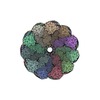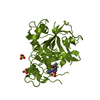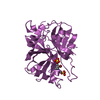+ Open data
Open data
- Basic information
Basic information
| Entry | Database: EMDB / ID: EMD-8855 | |||||||||
|---|---|---|---|---|---|---|---|---|---|---|
| Title | Cryo-EM structure of P. aeruginosa flagellar filaments A443V | |||||||||
 Map data Map data | Cryo-EM structure of P. aeruginosa flagellar filaments A443V | |||||||||
 Sample Sample |
| |||||||||
 Keywords Keywords | bacteria flagella / helical polymers / cryo-EM / PROTEIN FIBRIL | |||||||||
| Function / homology |  Function and homology information Function and homology informationbacterial-type flagellum / bacterial-type flagellum-dependent cell motility / structural molecule activity / extracellular region Similarity search - Function | |||||||||
| Biological species |  Pseudomonas aeruginosa PAO1 (bacteria) / Pseudomonas aeruginosa PAO1 (bacteria) /  Pseudomonas aeruginosa (strain ATCC 15692 / DSM 22644 / CIP 104116 / JCM 14847 / LMG 12228 / 1C / PRS 101 / PAO1) (bacteria) Pseudomonas aeruginosa (strain ATCC 15692 / DSM 22644 / CIP 104116 / JCM 14847 / LMG 12228 / 1C / PRS 101 / PAO1) (bacteria) | |||||||||
| Method | helical reconstruction / cryo EM / negative staining / Resolution: 4.2 Å | |||||||||
 Authors Authors | Wang F / Postel S | |||||||||
| Funding support |  United States, 1 items United States, 1 items
| |||||||||
 Citation Citation |  Journal: Nat Commun / Year: 2017 Journal: Nat Commun / Year: 2017Title: A structural model of flagellar filament switching across multiple bacterial species. Authors: Fengbin Wang / Andrew M Burrage / Sandra Postel / Reece E Clark / Albina Orlova / Eric J Sundberg / Daniel B Kearns / Edward H Egelman /  Abstract: The bacterial flagellar filament has long been studied to understand how a polymer composed of a single protein can switch between different supercoiled states with high cooperativity. Here we ...The bacterial flagellar filament has long been studied to understand how a polymer composed of a single protein can switch between different supercoiled states with high cooperativity. Here we present near-atomic resolution cryo-EM structures for flagellar filaments from both Gram-positive Bacillus subtilis and Gram-negative Pseudomonas aeruginosa. Seven mutant flagellar filaments in B. subtilis and two in P. aeruginosa capture two different states of the filament. These reliable atomic models of both states reveal conserved molecular interactions in the interior of the filament among B. subtilis, P. aeruginosa and Salmonella enterica. Using the detailed information about the molecular interactions in two filament states, we successfully predict point mutations that shift the equilibrium between those two states. Further, we observe the dimerization of P. aeruginosa outer domains without any perturbation of the conserved interior of the filament. Our results give new insights into how the flagellin sequence has been "tuned" over evolution.Bacterial flagellar filaments are composed almost entirely of a single protein-flagellin-which can switch between different supercoiled states in a highly cooperative manner. Here the authors present near-atomic resolution cryo-EM structures of nine flagellar filaments, and begin to shed light on the molecular basis of filament switching. | |||||||||
| History |
|
- Structure visualization
Structure visualization
| Movie |
 Movie viewer Movie viewer |
|---|---|
| Structure viewer | EM map:  SurfView SurfView Molmil Molmil Jmol/JSmol Jmol/JSmol |
| Supplemental images |
- Downloads & links
Downloads & links
-EMDB archive
| Map data |  emd_8855.map.gz emd_8855.map.gz | 42.5 MB |  EMDB map data format EMDB map data format | |
|---|---|---|---|---|
| Header (meta data) |  emd-8855-v30.xml emd-8855-v30.xml emd-8855.xml emd-8855.xml | 13.2 KB 13.2 KB | Display Display |  EMDB header EMDB header |
| Images |  emd_8855.png emd_8855.png | 101.2 KB | ||
| Filedesc metadata |  emd-8855.cif.gz emd-8855.cif.gz | 5.7 KB | ||
| Archive directory |  http://ftp.pdbj.org/pub/emdb/structures/EMD-8855 http://ftp.pdbj.org/pub/emdb/structures/EMD-8855 ftp://ftp.pdbj.org/pub/emdb/structures/EMD-8855 ftp://ftp.pdbj.org/pub/emdb/structures/EMD-8855 | HTTPS FTP |
-Validation report
| Summary document |  emd_8855_validation.pdf.gz emd_8855_validation.pdf.gz | 474.4 KB | Display |  EMDB validaton report EMDB validaton report |
|---|---|---|---|---|
| Full document |  emd_8855_full_validation.pdf.gz emd_8855_full_validation.pdf.gz | 474 KB | Display | |
| Data in XML |  emd_8855_validation.xml.gz emd_8855_validation.xml.gz | 4.7 KB | Display | |
| Data in CIF |  emd_8855_validation.cif.gz emd_8855_validation.cif.gz | 5.2 KB | Display | |
| Arichive directory |  https://ftp.pdbj.org/pub/emdb/validation_reports/EMD-8855 https://ftp.pdbj.org/pub/emdb/validation_reports/EMD-8855 ftp://ftp.pdbj.org/pub/emdb/validation_reports/EMD-8855 ftp://ftp.pdbj.org/pub/emdb/validation_reports/EMD-8855 | HTTPS FTP |
-Related structure data
| Related structure data |  5wk5MC  8847C  8848C  8849C  8850C  8851C  8852C  8853C  8856C  5wjtC  5wjuC  5wjvC  5wjwC  5wjxC  5wjyC  5wjzC  5wk6C C: citing same article ( M: atomic model generated by this map |
|---|---|
| Similar structure data |
- Links
Links
| EMDB pages |  EMDB (EBI/PDBe) / EMDB (EBI/PDBe) /  EMDataResource EMDataResource |
|---|
- Map
Map
| File |  Download / File: emd_8855.map.gz / Format: CCP4 / Size: 184.6 MB / Type: IMAGE STORED AS FLOATING POINT NUMBER (4 BYTES) Download / File: emd_8855.map.gz / Format: CCP4 / Size: 184.6 MB / Type: IMAGE STORED AS FLOATING POINT NUMBER (4 BYTES) | ||||||||||||||||||||||||||||||||||||||||||||||||||||||||||||
|---|---|---|---|---|---|---|---|---|---|---|---|---|---|---|---|---|---|---|---|---|---|---|---|---|---|---|---|---|---|---|---|---|---|---|---|---|---|---|---|---|---|---|---|---|---|---|---|---|---|---|---|---|---|---|---|---|---|---|---|---|---|
| Annotation | Cryo-EM structure of P. aeruginosa flagellar filaments A443V | ||||||||||||||||||||||||||||||||||||||||||||||||||||||||||||
| Projections & slices | Image control
Images are generated by Spider. generated in cubic-lattice coordinate | ||||||||||||||||||||||||||||||||||||||||||||||||||||||||||||
| Voxel size | X=Y=Z: 1.05 Å | ||||||||||||||||||||||||||||||||||||||||||||||||||||||||||||
| Density |
| ||||||||||||||||||||||||||||||||||||||||||||||||||||||||||||
| Symmetry | Space group: 1 | ||||||||||||||||||||||||||||||||||||||||||||||||||||||||||||
| Details | EMDB XML:
CCP4 map header:
| ||||||||||||||||||||||||||||||||||||||||||||||||||||||||||||
-Supplemental data
- Sample components
Sample components
-Entire : Pseudomonas aeruginosa flagella filament
| Entire | Name: Pseudomonas aeruginosa flagella filament |
|---|---|
| Components |
|
-Supramolecule #1: Pseudomonas aeruginosa flagella filament
| Supramolecule | Name: Pseudomonas aeruginosa flagella filament / type: complex / ID: 1 / Parent: 0 / Macromolecule list: all |
|---|---|
| Source (natural) | Organism:  Pseudomonas aeruginosa PAO1 (bacteria) Pseudomonas aeruginosa PAO1 (bacteria) |
-Macromolecule #1: B-type flagellin
| Macromolecule | Name: B-type flagellin / type: protein_or_peptide / ID: 1 / Number of copies: 41 / Enantiomer: LEVO |
|---|---|
| Source (natural) | Organism:  Pseudomonas aeruginosa (strain ATCC 15692 / DSM 22644 / CIP 104116 / JCM 14847 / LMG 12228 / 1C / PRS 101 / PAO1) (bacteria) Pseudomonas aeruginosa (strain ATCC 15692 / DSM 22644 / CIP 104116 / JCM 14847 / LMG 12228 / 1C / PRS 101 / PAO1) (bacteria)Strain: ATCC 15692 / DSM 22644 / CIP 104116 / JCM 14847 / LMG 12228 / 1C / PRS 101 / PAO1 |
| Molecular weight | Theoretical: 49.302906 KDa |
| Recombinant expression | Organism:  Pseudomonas aeruginosa PAO1 (bacteria) Pseudomonas aeruginosa PAO1 (bacteria) |
| Sequence | String: MALTVNTNIA SLNTQRNLNA SSNDLNTSLQ RLTTGYRINS AKDDAAGLQI SNRLSNQISG LNVATRNAND GISLAQTAEG ALQQSTNIL QRIRDLALQS ANGSNSDADR AALQKEVAAQ QAELTRISDT TTFGGRKLLD GSFGTTSFQV GSNAYETIDI S LQNASASA ...String: MALTVNTNIA SLNTQRNLNA SSNDLNTSLQ RLTTGYRINS AKDDAAGLQI SNRLSNQISG LNVATRNAND GISLAQTAEG ALQQSTNIL QRIRDLALQS ANGSNSDADR AALQKEVAAQ QAELTRISDT TTFGGRKLLD GSFGTTSFQV GSNAYETIDI S LQNASASA IGSYQVGSNG AGTVASVAGT ATASGIASGT VNLVGGGQVK NIAIAAGDSA KAIAEKMDGA IPNLSARART VF TADVSGV TGGSLNFDVT VGSNTVSLAG VTSTQDLADQ LNSNSSKLGI TASINDKGVL TITSATGENV KFGAQTGTAT AGQ VAVKVQ GSDGKFEAAA KNVVAAGTAA TTTIVTGYVQ LNSPTAYSVS GTGTQASQVF GNASAAQKSS VASVDISTAD GAQN AIAVV DNALAAIDAQ RADLGAVQNR FKNTIDNLTN ISENATNVRS RIKDTDFAAE TAALSKNQVL QQAGTAILAQ ANQLP QAVL SLLR UniProtKB: B-type flagellin |
-Experimental details
-Structure determination
| Method | negative staining, cryo EM |
|---|---|
 Processing Processing | helical reconstruction |
| Aggregation state | filament |
- Sample preparation
Sample preparation
| Concentration | 0.1 mg/mL |
|---|---|
| Buffer | pH: 7.4 / Details: PBS |
| Staining | Type: NEGATIVE / Material: negative stain |
| Grid | Pretreatment - Type: PLASMA CLEANING |
| Vitrification | Cryogen name: ETHANE / Chamber humidity: 90 % |
- Electron microscopy
Electron microscopy
| Microscope | FEI TITAN KRIOS |
|---|---|
| Image recording | Film or detector model: FEI FALCON II (4k x 4k) / Detector mode: INTEGRATING / Average exposure time: 2.0 sec. / Average electron dose: 20.0 e/Å2 Details: Images were stored containing seven parts, where each part represented a set of frames corresponding to a dose of ~20 electrons per Angstrom^2. The full dose image stack was used for the ...Details: Images were stored containing seven parts, where each part represented a set of frames corresponding to a dose of ~20 electrons per Angstrom^2. The full dose image stack was used for the estimation of the CTF as well as for boxing filaments. Only the first two parts were used for the reconstruction (~5 electrons per Angstrom^2). |
| Electron beam | Acceleration voltage: 300 kV / Electron source:  FIELD EMISSION GUN FIELD EMISSION GUN |
| Electron optics | Illumination mode: FLOOD BEAM / Imaging mode: BRIGHT FIELD |
| Experimental equipment |  Model: Titan Krios / Image courtesy: FEI Company |
- Image processing
Image processing
| Final reconstruction | Applied symmetry - Helical parameters - Δz: 4.61 Å Applied symmetry - Helical parameters - Δ&Phi: 65.75 ° Applied symmetry - Helical parameters - Axial symmetry: C1 (asymmetric) Algorithm: BACK PROJECTION / Resolution.type: BY AUTHOR / Resolution: 4.2 Å / Resolution method: OTHER / Software - Name: SPIDER / Details: model-map FSC 0.38 cut-off / Number images used: 102119 |
|---|---|
| Startup model | Type of model: OTHER / Details: featureless cylinder |
| Final angle assignment | Type: NOT APPLICABLE / Software - Name: SPIDER |
-Atomic model buiding 1
| Refinement | Space: REAL |
|---|---|
| Output model |  PDB-5wk5: |
 Movie
Movie Controller
Controller






 Z (Sec.)
Z (Sec.) Y (Row.)
Y (Row.) X (Col.)
X (Col.)





















